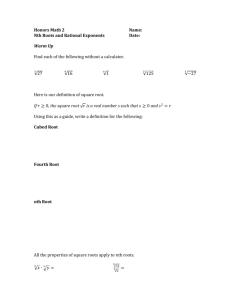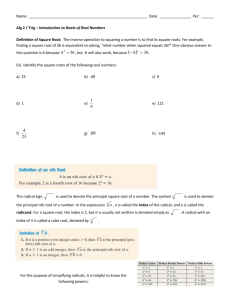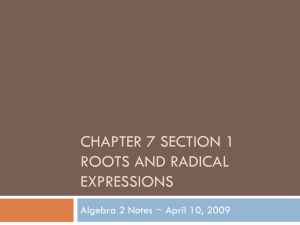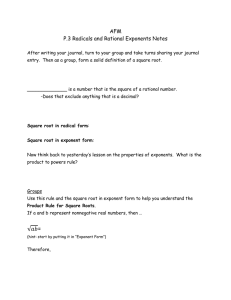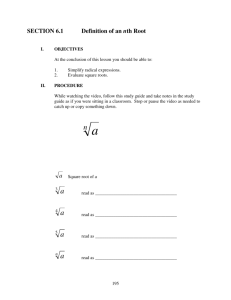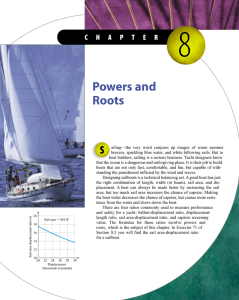REVIEW OF ROOTS AND RADICALS
advertisement
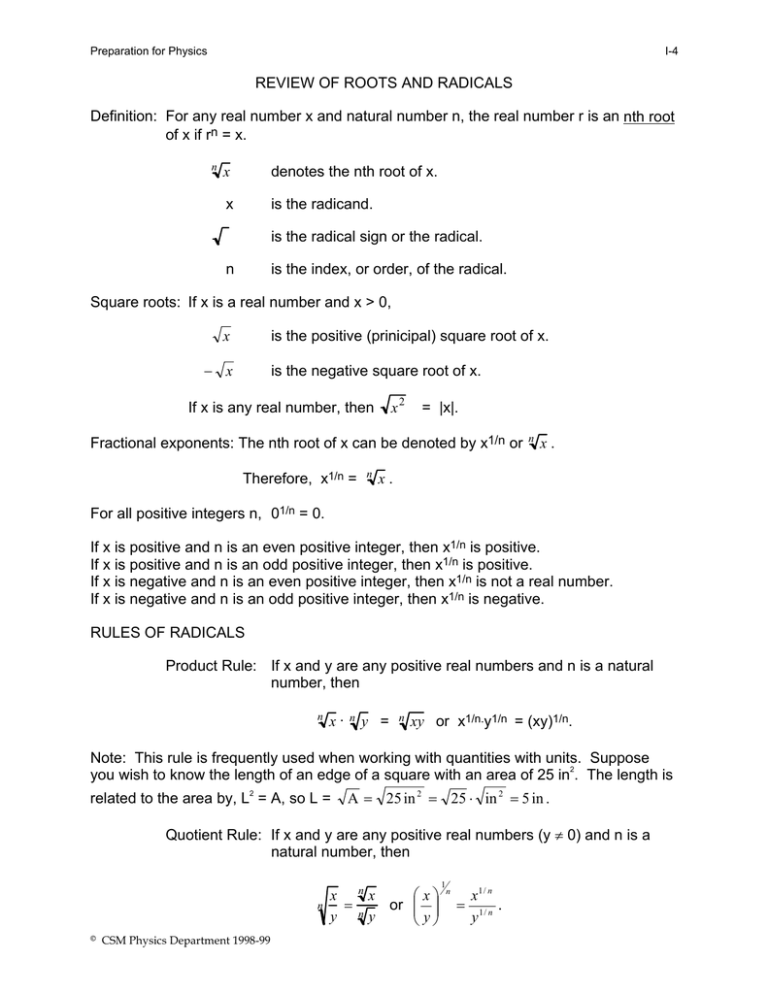
Preparation for Physics I-4 REVIEW OF ROOTS AND RADICALS Definition: For any real number x and natural number n, the real number r is an nth root of x if rn = x. n x denotes the nth root of x. x is the radicand. is the radical sign or the radical. n is the index, or order, of the radical. Square roots: If x is a real number and x > 0, is the positive (prinicipal) square root of x. x − x is the negative square root of x. x2 If x is any real number, then = |x|. Fractional exponents: The nth root of x can be denoted by x1/n or n Therefore, x1/n = n x. x. For all positive integers n, 01/n = 0. If x is positive and n is an even positive integer, then x1/n is positive. If x is positive and n is an odd positive integer, then x1/n is positive. If x is negative and n is an even positive integer, then x1/n is not a real number. If x is negative and n is an odd positive integer, then x1/n is negative. RULES OF RADICALS Product Rule: If x and y are any positive real numbers and n is a natural number, then n x. n y = n xy or x1/n.y1/n = (xy)1/n. Note: This rule is frequently used when working with quantities with units. Suppose you wish to know the length of an edge of a square with an area of 25 in2. The length is 2 related to the area by, L = A, so L = A = 25 in 2 = 25 ⋅ in 2 = 5 in . Quotient Rule: If x and y are any positive real numbers (y ≠ 0) and n is a natural number, then n © CSM Physics Department 1998-99 x = y n n ⎛x⎞ x or ⎜⎜ ⎟⎟ y ⎝ y⎠ 1 n = x1 / n . y1/ n Preparation for Physics I-5 Power Rule: If m and n are positive integers, then ( ) = (x ) x m / n = x1 / n m m 1/ n provided all indicated roots exist. If x m / n exists and x ≠ 0, then x − m / n = 1 x m/n . Since radicals can be written in fractional exponent form, these and other rules follow from the definitions and rules of exponents. COMMONLY CONFUSED EXPRESSIONS (1) x 1 / n ≠ n (2) 1 xn x+ y ≠ n x +n y EXERCISES 1. Find examples that illustrate commonly confused expressions (1) and (2). 2. Without using a calculator, find the numerical equivalent of (that is, solve) each of the following. 4 + 25 a. b. 641/2 - 361/2 d. 1251/3 + 6251/4 3 g. e. 100 31012 3 10 3 c. 3 27 − 4 16 f. 1251/3 x 251/2 8 9 h. (1027) –1/3 x (1010)2/5 9 3. Simplify each expression if possible. Assume that all indicated roots exist. a+ b a. b. 3 3 d. 2 σ ⋅ σ c. 2 3 σ − 3 σ ( ) ( ) 2 6 e. ⎛⎜ 3 27 x 2 y ⎞⎟⎛⎜ 3 8 x3 y 6 ⎞⎟ ⎝ ⎠⎝ ⎠ g. 3 (α + β ) 6 © CSM Physics Department 1998-99 σ −4 σ 3 (α + β ) f. ( (6 x y ))( (36 x y )) h. ( (λ + μ ) )(λ + μ ) 2 3 6 3 6 4 3 3 (λ + μ ) 9 2 Preparation for Physics 3 i. I-6 [ (λ + μ ) + ( λ + μ ) 3 ( λ + μ )9 6 j. ( z + T ) ( (a + b) )( (a + b) ) k. 5 3 3 ( 4 3 ) ( © CSM Physics Department 1998-99 ) ] −1 3 [ × (z + T ) 27 ] 2 6 ( (ab) )( (ab) ) 51 5 5 l. (a + b)12 ⎛ 3 3 p 2 q 5 ⎞ 3 (3 p 5 q 2 ) 4 ⎟ ⎜ ⎠ ⎝ m. 3 ( p 6q 2 )2 36 5 ( 21 ( ab)12 ) ( ⎛ 4 6 x 2 y 3 2 ⎞ 4 (3 x 3 y 4 )5 ⎟ ⎜ ⎠ ⎝ n. 4 (12 x 5 y 2 )3 )
